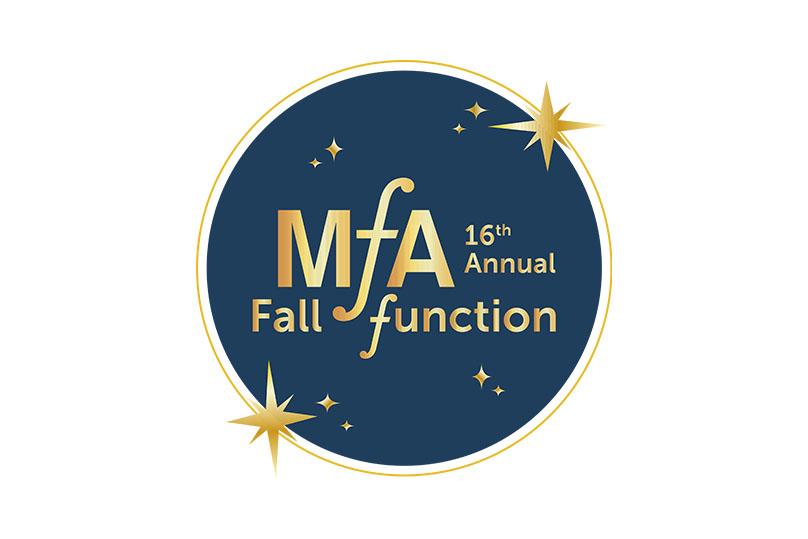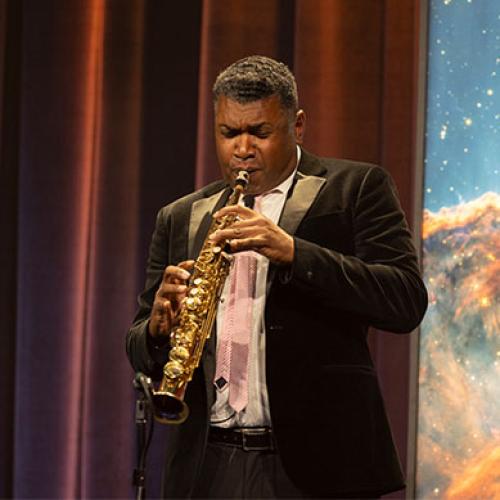

NEW YORK, NY – Math for America’s (MƒA) 16th Annual Fall ƒunction gala, held Saturday, November 9 at the Marriott Marquis in Times Square, celebrated more than 900 accomplished New York City mathematics and science teachers for making a lasting impact in local schools, communities, and the teaching profession at large. The event brought together more than 1,200 leaders in education to honor expert professionals who advance the profession through collaboration, learning, and leadership.
This year's Fall ƒunction, a celestial affair, featured a cocktail reception and dinner, highlighted by a keynote address from Stephon Alexander, professor of physics, Brown University. Alexander shared his presentation “The Jazz of Spheres” using the language of music to describe the cosmic and mathematical mysteries of the big bang. He discussed how his high school teacher and mentors inspired his journey between music, math and physics, and ended with an Improvisational Jazz Saxophone rendition.
Alexander is an theoretical physicist of international repute, author, and jazz musician whose work is at the interface between cosmology, particle physics, quantum gravity, AI and music technology. His expertise lies in constructing new theories of the early universe and elementary particle physics that have predictions for the universe at present, such as dark energy and dark matter. He also combines mathematics and tools from theoretical physics into machine learning, geometry and music cognition and theory. Alexander is a past President of the National Society of Black Physicists and is currently the CEO and Founder of Sound+Science Inc, a nonprofit organization focused on high school music and science students. He was previously the Executive Director of the Harlem Gallery of Science and is currently on the MƒA Board of Directors. He had previous appointments at Stanford University, Imperial College, Penn State, Dartmouth College and Haverford College. Alexander is a specialist in the field of string theory and cosmology, where the physics of superstrings are applied to address longstanding questions in cosmology. In 2001, he co-invented the model of cosmic inflation based on string theory. In his critically acclaimed book, The Jazz of Physics, Alexander revisits the ancient interconnection between music, astrophysics and the laws of motion. He explores new ways music mirrors modern physics and discusses innovations in physics that have been and can be inspired from "improvisational logic" exemplified in Jazz performance and practice.

Stephon Alexander, Professor of Physics, Brown University

Pearl Ohm, MƒA Master Teacher, Essex Street Academy
In addition, MƒA Master Teacher Pearl Ohm shared her personal journey of growth and learning, detailing how she discovers ways to push the boundaries of what’s possible in education. She called on all educators to embrace the discomfort that comes with trying something new, explaining how doing so can bring positive change to individual teachers and the teaching profession as a whole.
Ohm started her NYC teaching career as a 2005 MƒA Fellow, and has exclusively taught at small, Consortium schools. She emphasizes constructivist, inquiry-based understanding in all her mathematics classes, including those she currently teaches at Essex Street Academy, a small unscreened high school with open admissions for students from all boroughs. Throughout her career, Ohm has served as mathematics department chair, mathematics department mentor, inquiry team member, professional development facilitator, scheduling programmer, and union chapter leader. She has served multiple terms as the Director of the NYC Fellowship for STEM-Ed Innovators, is working to complete the NYU Metro Center facilitative leadership certification program, and will be a dual certified math and special education teacher come September 2025 through the MƒA-Hunter SPED-ACT program. Ohm actively leads courses at MƒA with a focus on student learning and facilitates workshops for the New York Performance Standards Consortium with a focus on inclusive practices. Entering her nineteenth year in the classroom, she spends a lot of time thinking about the institution of education and its barriers, increasing equity, and dismantling systems of oppressions. Ohm received her M.A. in Secondary Mathematics Education at Teachers College at Columbia University and her B.S. in Industrial Engineering at Lehigh University.
MƒA teachers teach in close to 400 New York City schools across all five boroughs reaching approximately 100,000 students. Throughout their fellowships, MƒA teachers are provided powerful opportunities to build relationships and get new ideas from similarly dedicated peers. The MƒA community being recognized at the event includes more than 700 high school teachers, more than 150 middle school teachers, and more than 50 elementary school teachers, with more than 400 teaching mathematics and more than 500 teaching science.

